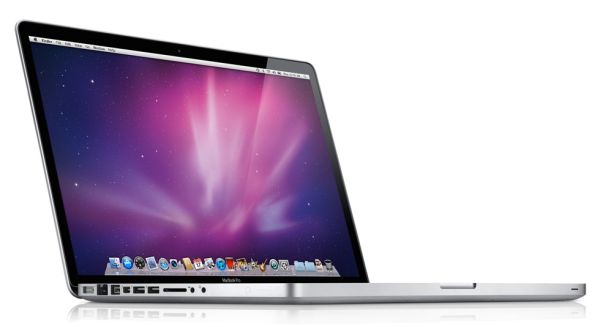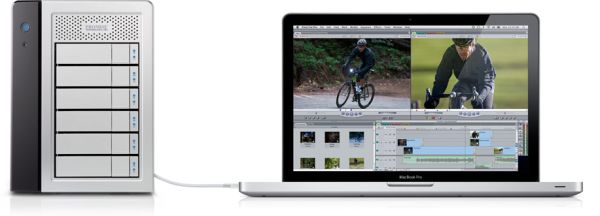As expected, Apple today unveiled a range of speed and functionality improvements for its MacBook Pro lineup. The update was unusually quiet for Apple. There was no scheduled press event and nothing more than a press release announcing the specs and availability. Apple retail stores received stock prior to today and began selling product immediately. The Apple online store also has immediate availability.
No mere speed bump, these new MacBooks bring Intel’s new Sandy Bridge processors chipsets to the entire line, replacing the previous Arrandale processors and finally retiring the aging Core 2 Duo from service in the 13-inch model.
Contrary to earlier reports, there are no default SSD configurations although the solid state offerings are still optional. The big new feature (outside of Sandy Bridge) is support for the first incarnation of Intel’s Light Peak interface technology, now called Thunderbolt.
When Apple moved its MacBook Pro lineup to Arrandale, the poor 13-inch model lost out - it remained with an older Core 2 Duo CPU. The move to Sandy Bridge is different - all models got an upgrade.
Sandy Bridge is used across the board and interestingly enough only the 13-inch model uses a dual-core CPU. Both the 15-inch and 17-inch MacBook Pros now feature quad-core CPUs. This makes these two MacBook Pros ripe for a desktop replacement usage model, particularly if paired with an SSD.
Sandy Bridge obviously integrates Intel’s HD 3000 graphics on die, which is used by all of the new MBPs by default. The 15-inch model and 17-inch model add switchable dedicated graphics from AMD, ousting the NVIDIA chips that powered the previous lineup. I wouldn’t read too much into this – Apple is always going back and forth between NVIDIA and AMD graphics, usually based on whoever happens to be offering the best or most efficient chip at the time of refresh.
Per usual, this refresh sees Apple offering customers more computer for the same money, rather than giving out any substantial price cuts. This is nothing specific to Apple but rather a benefit of buying in an industry driven by Moore's Law.
One number on this spec sheet sticks out like a sore thumb from the rest, and that is Apple's decision to offer 5400RPM SATA hard drives as the default storage option across the line. The price differential between 5400 RPM drives and 7200 RPM drives is negligible these days, and for these prices, the company could certainly afford to address this performance bottleneck. I would hope that Apple would at least consider Seagate’s hybrid drive as an alternative until we get Intel enabled SSD caching.
Upgrades to 128GB, 256GB, and 512GB solid state drives available but predictably costly ($250, $650, and a whopping $1,250, respectively). It is worth noting that at $250 for a 128GB SSD, Apple’s upgrade pricing isn’t too far off what the market value is for the lowest end SSD. The 256GB pricing is a bit insane.
Apple has finally standardized on 4GB of memory across the board, although I would’ve liked to have seen 8GB offered on the higher end configurations.
Also new is what Apple calls a "FaceTime HD camera," which looks to be a high definition version of Apple's standard webcam - not much more that's noteworthy about this, except that the iSight moniker is continuing its slow disappearance from Apple's spec sheet one model at a time.
It is disappointing that Apple makes no mention of QuickSync in its announcement. The hardware video transcoding engine is a key part of Sandy Bridge, however it looks like OS X support for the technology may not be ready quite yet.
It’s worth noting that Apple’s new laptops were apparently not delayed much by the SATA bug discovered in the 6-series chipsets last month – this likely means that Apple is shipping the affected B2 stepping parts but only using the 6Gbps ports.
There’s no change in chassis size or weight with the new MacBook Pros, this is an internal upgrade. Well, mostly...
Thunderbolt
The new MacBook Pros offer the array of ports we're used to, plus something a bit different.
A new port called Thunderbolt replaces the Mini DisplayPort found in earlier models. Formerly codenamed Light Peak, the new Intel standard promises up to 10 Gbps bi-directional data transfer speeds and connectivity for an array of devices, from displays to hard drives. The standard also supports 8-channel audio, which should make for easy connection to HDMI devices with the right adapter, and up to six different Thunderbolt devices can be daisy chained together according to the Intel specs.
Most of the given use scenarios for Thunderbolt focus on external hard drives, displays, and HD video hardware, and adapters for existing standards like eSATA and Firewire. If Thunderbolt ports become more widespread, we'll probably see additional applications of the standard.

Finally, it's worth noting that if you've already spent money on Mini DisplayPort adapters, dongles and cables for your existing Mac, those accessories will continue to work with the new Thunderbolt port.
Look for more from us on Thunderbolt shortly.
Conclusions
Thunderbolt aside, there's not much that surprises about the new MacBook Pro lineup - as usual, new, faster hardware is being sold to us in the same attractive unibody case to which we've become accustomed.
Most of the additions are welcome, though the value proposition continues to be a struggle. As usual, to save money, you're better off buying the base model and adding RAM or a new hard drive yourself than paying Apple's price for upgrades.
The move to Sandy Bridge is interesting but the lack of any mention of Quick Sync is a bit bothersome. We’re working on our review of the new platforms, expect to see results in the coming days.



